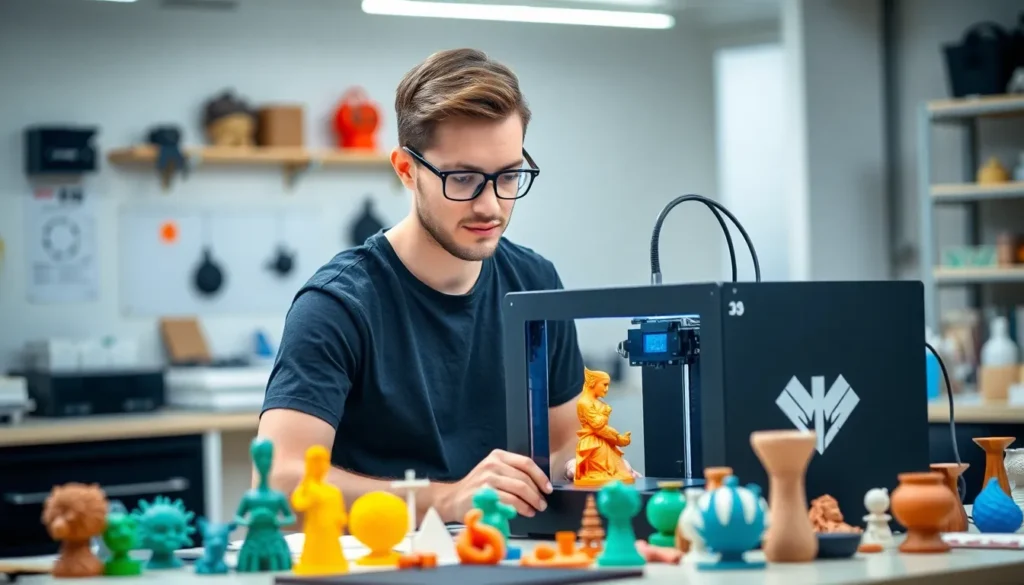In a world where creativity meets technology, 3D printing has emerged as a goldmine for those ready to roll up their sleeves. Imagine turning your wildest ideas into tangible products while fattening your wallet. Sounds like a dream, right? Well, it’s time to wake up and smell the filament!
Table of Contents
ToggleUnderstanding 3D Printing
3D printing emerges as a transformative technology that allows users to create three-dimensional objects from digital designs. This innovative process empowers individuals to turn concepts into tangible products, unlocking various creative and economic opportunities.
What Is 3D Printing?
3D printing refers to additive manufacturing techniques that build objects layer by layer from digital files. This method contrasts with traditional subtractive manufacturing, where materials are cut away to shape the final product. Users can design unique items using computer-aided design (CAD) software or download pre-made models from online repositories. Objects can range from prototypes and custom jewelry to functional tools, each tailored to specific needs.
Various 3D Printing Technologies
Several types of 3D printing technologies exist, each serving different applications and industries. Fused Deposition Modeling (FDM) stands out for its ease of use and affordability. Selective Laser Sintering (SLS) utilizes a laser to fuse powdered materials, creating durable parts. Stereolithography (SLA) employs ultraviolet light to cure resin into precise shapes, offering high-resolution results. Digital Light Processing (DLP) resembles SLA but uses a digital light projector for faster printing speeds. Understanding these technologies aids in selecting the best option for specific projects and business strategies.
Identifying Profitable Niches

Identifying profitable niches is essential for maximizing income through 3D printing. Focusing on specific markets can increase success rates.
Popular Products to Create
Functional items generate steady demand. Custom phone cases appeal to a wide audience. Unique figurines and toys attract collectors. Home decor items, such as vases and wall art, suit various tastes. Personalized gifts remain sought after for special occasions. These products offer the opportunity to cater to diverse customers.
Analyzing Market Demand
Evaluating market demand ensures the viability of 3D printing ventures. Researching existing trends helps identify gaps. Tools like Google Trends and social media provide insights into popular products. Engaging with online communities reveals customer preferences. Analyzing competitors highlights successful strategies and potential pitfalls. Assessing local markets can uncover niche opportunities that larger companies may overlook.
Setting Up Your 3D Printing Business
Establishing a 3D printing business involves several key steps that ensure successful operations. Start by investing in reliable equipment and software tailored to your needs.
Essential Equipment and Software
High-quality printers play a crucial role in business success. Fused Deposition Modeling (FDM) printers are popular for their affordability and versatility. Upgrading to Selective Laser Sintering (SLS) can enhance production quality. Additionally, slicing software like Cura or PrusaSlicer streamlines the design-to-print process. Ensure the inclusion of a computer with design software for creating and modifying 3D models, such as Blender or Tinkercad. Business owners must also consider materials like PLA and ABS filaments, which affect the final product’s quality. Keeping an inventory of spare parts and accessories enhances operational efficiency.
Pricing Your Products
Establishing competitive pricing requires careful analysis of production costs. Analyze material expenses, printer maintenance, and labor costs when determining product prices. Utilizing research tools assists in understanding local market prices and competitive offerings. Setting a price margin of 30% to 50% helps maintain profitability while remaining attractive to customers. Offering discounts or bundle deals can entice customers to buy more, increasing overall sales volume. Regularly reassess pricing strategies based on market trends ensures ongoing competitiveness and profitability.
Marketing Your 3D Printed Products
Marketing strategies play a vital role in the success of selling 3D printed products. Effective outreach attracts customers and boosts sales.
Online Platforms to Sell
Etsy thrives as a popular marketplace for handmade and unique items, making it suitable for 3D printed products. Amazon provides a vast audience, allowing sellers to reach diverse customers quickly. For niche markets, eBay offers auction-style listings that cater to collectors and enthusiasts. Shopify delivers customizable online store solutions suited for businesses wanting to build brand identity. Each platform presents unique selling features that cater to different product types and target audiences.
Utilizing Social Media for Promotion
Facebook serves as a versatile platform, enabling sellers to create business pages and join relevant groups. Instagram’s visual focus allows creators to showcase stunning 3D printed designs through appealing images and videos. TikTok offers engaging short-form content, helping to demonstrate product functionality and design processes. Twitter facilitates real-time engagement with customers, promoting flash sales or new products instantly. LinkedIn connects businesses with professionals, opening opportunities for collaborations and partnerships. Each social media platform can amplify advertising efforts and foster direct interactions with potential buyers.
Maximizing Profitability
Increasing profitability in 3D printing relies on several key strategies that enhance efficiency and customer loyalty.
Streamlining Production Processes
Optimizing production processes reduces costs and improves output. Implementing automated workflows, such as using advanced slicing software, can accelerate design preparation. Adopting techniques like batch printing allows creators to produce multiple items simultaneously, maximizing both time and material use. Utilizing high-quality materials decreases prints’ failure rates, leading to fewer resources wasted. Assessing the printing environment, including temperature and humidity controls, fosters better printing conditions. As projects scale, integrating inventory management software ensures efficient tracking of materials and finished products, streamlining operations overall.
Building Customer Relationships
Establishing strong relationships with customers drives repeat business. Engaging with customers through personalized communications can significantly enhance their experience. Offering after-sales support, including how-to guides and troubleshooting resources, builds trust and satisfaction. Gathering customer feedback helps adapt products to meet evolving preferences. Utilizing email marketing to share updates and promotions keeps products top-of-mind. Additionally, creating loyalty programs encourages customer return visits and increases lifetime value. Active participation in online communities fosters a sense of belonging and enhances the brand image. Building connections ultimately transforms one-time buyers into loyal customers.
Embracing the world of 3D printing can open doors to diverse income streams for those willing to explore its potential. By identifying profitable niches and creating unique products, individuals can tap into a growing market eager for innovation.
Investing in quality equipment and leveraging effective marketing strategies are crucial steps toward establishing a successful business. Engaging with customers and adapting to their needs also plays a significant role in fostering loyalty and driving repeat sales.
With the right approach and dedication, 3D printing can transform creative ideas into a thriving venture, allowing entrepreneurs to not just make money but also bring their imaginative visions to life.





